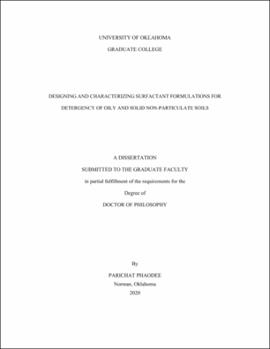| dc.description.abstract | Laundry detergency is a complex process at the nexus of soil, surfactant, solid substrate, and wash condition. This dissertation contains the following two major topics. The first topic focused on developing surfactant formulations capable of providing effective cold-water detergency of coconut oil below its melting point. While the cold-water detergency of coconut oil below its melting point on 65/35 polyester/cotton surface was poor using a 0.1 w/v% branched C14-15-8PO-SO4Na surfactant alone, coconut oil removal was found to be higher with the addition of intermediate chain alcohols (C7-C9 alcohols) than those of shorter and longer alcohols. Further detergency improvement was observed with added salt at optimum salinity (S*). Octanol was selected as an intermediate chain alcohol representative to evaluate detergency with the presence of branched octanols (2-octanol and 2-ethyl-hexanol) in the surfactant formulation. The interfacial tensions (IFT) measurement between the surfactant and melted coconut oil revealed that the S* required decreased from 8 w/v% NaCl for no alcohols to 4 w/v% NaCl for 1-octanol and to 2 w/v% NaCl for 2-octanol and 2-ethyl-hexanol. Comparing cold-water detergency using the surfactant system with added S*, the detergency of coconut oil increased from roughly 49% removal for no alcohol with 8 w/v% NaCl, to 83% removal for 2-ethy-hexanol with 2 w/v% NaCl, to 95% removal for 1-octanol with 4 w/v% NaCl, and to 98% removal for 2-octanol with 2 w/v% NaCl. Further, optimized surfactant formulations were tested with the effect of alcohol concentration as a final optimization study. Decreasing 1-octanol concentration from 90 mM (1.2%) to 15.3 mM (0.2%) and 2-octanol from 90mM (1.2%) to 38.5 mM (0.5%), their detergency still retained exceeding 90% removal. This work found that improved detergency of coconut oil below its melting point appeared to associate with a reduction in IFT (below 1 mN/m), enhanced wetting of the soil surface, and increasing solubilization of the removed soil in surfactant micelles. However, the studies of melting point alteration and dispersion stability were not found to correlate to enhanced detergency.
The second topic of this research attempted to demonstrate a correlation between detergency of a wide range of soils and surfactant-systems hydrophilic-lipophilic deviation (HLD) values. Two anionic surfactant systems (C10-4PO-SO4Na and a binary mixture of C10-4PO-SO4Na and AOT at 1:1 by molar ratio) were characterized surfactant characteristics using HLD concept. The results suggested that the single C10-4PO-SO4Na surfactant was more hydrophilic than the mixed surfactant system due to more negative Cc value. Detergency using a 0.1 w/v% C10-4PO-SO4Na surfactant was first conducted using five different oily soils with widely varying equivalent alkane carbon numbers (EACNs) from 5.2 to 16.6 (ranging from low to high hydrophobicity). The detergency was conducted at different NaCl concentrations corresponding to HLD values, ranging from negative (Type I microemulsion), to zero (optimum Type III microemulsion), and to positive (Type II microemulsion). The detergency increased with increasing NaCl concentrations (beginning at HLD = -3 for most cases), reached a maximum at its S* (HLD = 0), and decreased with further increasing NaCl concentrations over the S* (HLDs > 0). Effective oily soil removal (> 80% removal) was observed at widely varying NaCl concentrations which corresponded to an identical HLD range between -3 and 0 with IFTs below 1 mN/m. The mixture of C10-4PO-SO4Na and AOT was then studied as a confirmatory surfactant system. Likewise, the detergency trend was observed with varying NaCl concentrations and the HLD range between -3 and 0 showed excellent detergency of studied soils (lowest and highest EACNs). Finally, the mixed surfactant system was further evaluated detergency of octadecane (EACN = 18, solid non-particulate at 25°C) and demonstrated that detergency using surfactant systems with the HLD values between -3 and 0 was superior than other HLD ranges. Thus, this work suggests the utilization of HLD concept as a valuable tool for designing optimum detergency formulations for a wide range of soils. | en_US |
